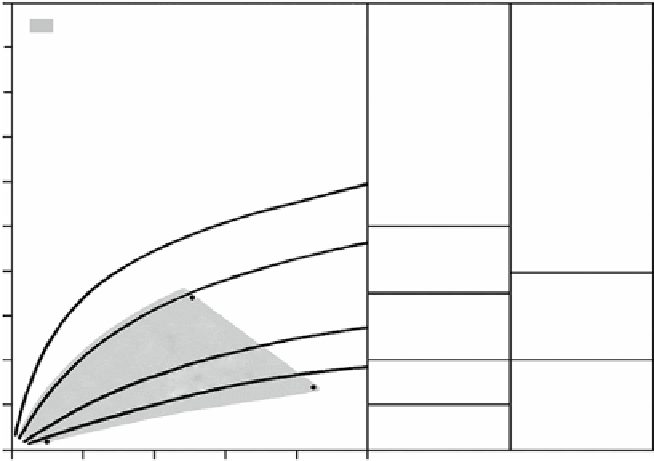Geology Reference
In-Depth Information
the twentieth century (Kindle
1917
), especially when,
in 1928, Rudolf Richter founded the Senckenberg
Research Station for Marine Geology and Palaeontology
in Wilhelmshaven on the North Sea coast of Germany.
It was the first institution worldwide specifically
dedicated to tidal flat research (Ginsburg
1975
). Earlier
studies either focused on regional physiographic
descriptions (Arends
1833
), coastal barrier formation
(de Bèaumont
1845
), or shore processes in general
(Johnson
1919
). Selections of historical benchmark
papers on barrier islands and tidal flats can be found in
Schwartz (
1973
) and Klein (
1976
). Recent summaries
of the main characteristics of tidal flats and tidal envi-
ronments can be found in Flemming (
2003a, b,
2005
).
tidal currents. The tidal prism is a function of tidal
range, basin surface area and filling efficiency, the
latter depending on the inlet cross-section (Van Veen
1950
). As a consequence, barrier islands progressively
decrease in size the larger the tidal prism gets with
increasing tidal range (Oost and de Boer
1994
; Davis
and Flemming
1995
) before degenerating into scat-
tered ephemeral sand bank islands when a certain
limit is exceeded (Reineck
1987
). Because of this,
Hayes (
1979
) proposed a new tidal classification in
which five subdivisions are distinguished (<1 m:
microtidal; 1-2 m: lower mesotidal; 2-3.5 m: upper
mesotidal; 3.5-5.0 m: lower macrotidal; >5.0 m: upper
macrotidal) (Fig.
10.2
). It represents a refinement of
the more commonly used classification of Davies
(
1964
) that only distinguishes three categories (<2 m:
microtidal; 2-4 m: mesotidal; >4 m: macrotidal). The
geographic distribution of tidal ranges according to the
more detailed classification of Hayes (
1979
) has been
included in Fig.
10.1
and can also be found in Flemming
(
2005
). In addition to being morphogenetically more
meaningful, it also provides a much better spatial
resolution of tidal regimes around the world than the
older one.
As shown by Davis and Hayes (
1984
), a second
important hydrodynamic factor limiting barrier stability
10.2
Hydrological Constraints
Barrier island systems, and hence back-barrier tidal
flats, are typically restricted to tidal ranges of up to
about 3.5 m (Hayes
1979
). Above this limit, the tidal
prism or water masses moving toward and away from
the coast during each tidal cycle are generally so large
that there is literally no room left for barrier islands to
exist, wave action being unable to counteract the strong
10
Classification of
Hayes (1979)
Classification of
Davies (1964)
Stability field of modern barrier islands
8
UPPER
MACROTIDAL
MACROTIDAL
6
LOWER
MACROTIDAL
4
GB
?
MESOTIDAL
UPPER
MESOTIDAL
?
2
?
LOWER
MESOTIDAL
ICE
MICROTIDAL
MICROTIDAL
NWF
0
0
0.5
1.0
1.5
2.0
2.5
Mean wave height (m)
Fig. 10.2
Barrier-island stability as a function of wave climate and tidal range relative to the classification schemes of Davies
(
1964
) and Hayes (
1979
)


